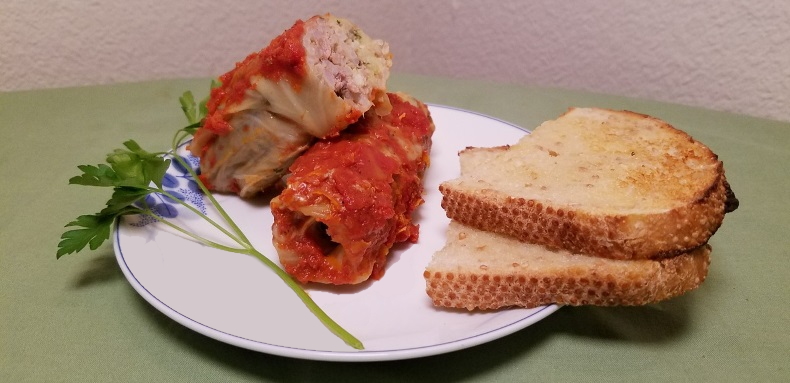The Participant Observer Recipe of the Month is for Polish Gołąbki, aka stuffed cabbage rolls. A relatively easy dish to prepare, Gołąbki can be eaten as a snack or as a main course. 
Gołąbki
Few culinary concoctions are as wide-spread as stuffed cabbage rolls. Gołąbki is one of the national dishes of Poland, but stuffed cabbage leaves can be found in much of Eastern, Central Europe, Turkey, Galacia, Greece, Italy, Ireland, Western Asia, North Africa, Scandinavia, China, Korea, Japan, South America and many many other places. Indeed, if you Google a country or culture name along with "stuffed cabbage", you are likely to find a recipe! Stuffed cabbage rolls known as holishkes (or prakas) are often enjoyed by Eastern European Jews and their descendants, particularly for the seven-day autumn harvest festival known as Succoth (in remembrance of the Exodus). It is possible that stuffed cabbage rolls existed in Jewish cooking as long ago as 2,000 years ago, but the immense geographic distribution suggests multiple independent inventions. However, nowhere else are stuffed cabbage rolls as quintessential to a cultural cuisine as they are in Poland. "GoÅ‚Ä…bki" (pronounced "go-woomp-kee") means "little pigeons" in Polish and the same metaphor to describe them is used in Russia and Ukraine. There is also a Polish village named GoÅ‚Ä…bki. Dolmathes are the Greek version of this idea, using grape leaves instead of cabbage leaves. In Poland and Russia, fermented cabbage leaves are sometimes used instead of boiled leaves.
While the type of cabbage is dictated by what is locally available, the ingredients found in the stuffing and accompanying sauce varies. Rice is frequently used, but barley is also used. Generally, lamb, pork or ground beef is used as a protein. The dish is made savory by the addition of onions and garlic and spices are often limited to salt, pepper and perhaps an aromatic herb. A simple tomato sauce is most often used, but they can be eaten with sour cream or plain. The filling is often "bound" with raw egg, making it more solid than crumbly.
Cook's notes:
- There are two main ways of cooking Gołąbki, either by boiling them or baking them. If you boil them, you can use uncooked rice; if you bake them you need to cook the rice first. Once source claims that the oldest technique was baking them.
- Eggs are typically used as a binder, but if you can't eat or don't like eggs, you can use 1 cup of tomato puree.
- Gołąbki freeze well. They can be microwaved, steamed or fried after thawing.
- Like so many other savory dishes, Gołąbki taste better the next day after the flavors fully develop.
Ingredients:
- 1 large head of cabbage (3 pounds)
- 1 large onion, chopped finely
- 1 pound of ground beef
- 1/2 pound of ground pork (optional, if not used add 1/2 pound more of ground beef)
- 2 large eggs
- Olive oil or butter
- 1 1/2 cups of cooked rice (white or brown) cooked "al dente" (in other words, not completely soft)
- 1 tablespoon crushed or chopped garlic
- 1 teaspoon dried ground marjoram
- 2 teaspoons of salt
- 1 teaspoon ground black pepper
- 1/4 cup of finely chopped Italian parsley
- 1 cup tomato puree
- 1 cup beef or chicken stock (or cabbage water)
Preparation:
- Core the cabbage head (cut a conical piece out of the bottom, penetrating about a 1/3 of the way into the cabbage).
- Bring a large stockpot of salted water to a boil.
- Add the whole cabbage (cored side down) , cover the pot, reduce the heat and simmer for 8 minutes.
- Transfer the cabbage to a large pot of cold water to cool it. Note: do not throw out the water it was cooked in; you might need it.
- Gently peel of the leaves of the cabbage one by one. Note: you may have to re-boil the inner part of the cabbage to make the leaves sufficiently pliable.
- With a sharp knife shave down the central vein on the outside (convex side)of each individual leaf to match the thickness of the rest of the leaf. Note: the outer leaves are not as good to use as the inside leaves, and the veins in the inside leaves are less pronounced. Save any leaves you don't use in making the rolls.
- Sauté the onions and garlic in olive oil over medium high heat until they are either translucent or browned.
- Mix in the crushed garlic and sauté for an additional minute.
- Transfer the onions and garlic to a large mixing bowl to cool.
- After the onions and garlic are cooled (10 minutes) mix the rice, ground beef, marjoram, parsley, salt, and 2 eggs. Do not overmix.
- Lay a leaf a single cabbage leaf down with the edges curled up (inside concave side).
- Spoon the filling onto the edge closest to you. Roll the edge of the leaf until the leaf covers the filling, then fold in the sides and continue rolling.
- The amount of filling for each roll varies according to the size of leaf. The desirable target is a roll that is about 6 inches wide and 2 inches thick.
- Make tomato sauce by combining 1 cup of tomato puree, 1 cup of cabbage water or stock, and salt and pepper to taste.
- Placed cabbage rolls in a dutch oven or oven pan. You may need to do this in layers depending on the size of your pan. Pour tomato sauce over the rolls and blanket everything with the leftover cabbage leaves.
- cover the pan with a lid or tightly with aluminum foil.
- Bake the Gołąbki at 350 F for 1 hour.
- Remove Gołąbki from the oven and let cool for 15-20 minutes.
- Serve with rye bread.
Smacznego!
Recipe by T. Johnston-O'Neill
Photos by Shari K. Johnston-O'Neill








